It’s almost become a cliche that we live in a golden age of long range optics with more good options available than ever before, but it’s true. Soon after I finished my review of the Burris XTRIII, Burris was about to update their RT line with two RT Long Range scopes. These two new options would provide long range shooters with an affordable scope in 3-15X and 5-25X that shared some features with its bigger brothers. Burris was kind enough to send me a new RT25 for this review and I wanted to share some of my thoughts on this scope.
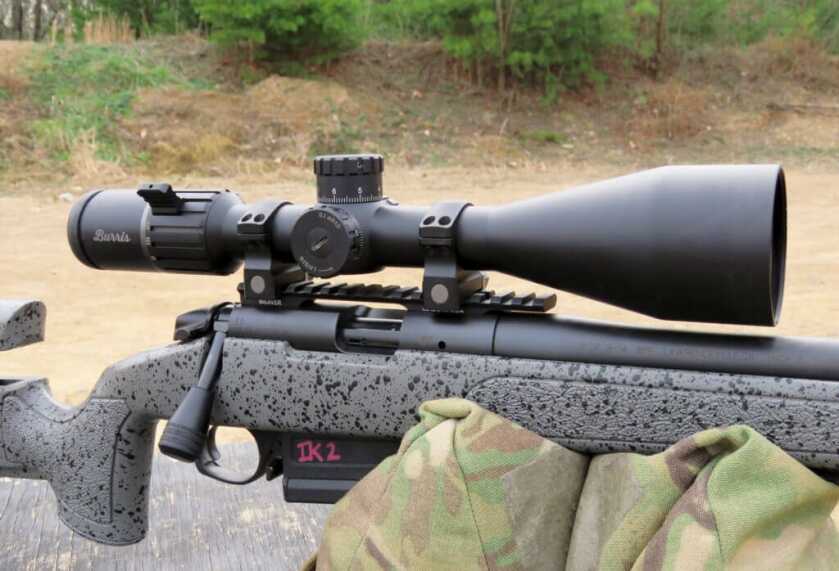
Unfortunately, I received the scope just in time for record shortages of ammunition nationwide, so I mounted the scope up to a Bergara B14R since I had plenty of .22LR to use. Putting the scope on a precision rimfire had some advantages as it would allow me to thoroughly test the tracking, repeatability, and image quality while shooting a .22LR to unreasonable distances. Before I get into all of that though let’s do a quick overview of the scope to check out what makes this scope so nice.
Overview
At 14.3” long and weighing just slightly less than 25 oz it makes the scope a nice, svelte package that’s at home on most rifles. Magnification is 5-25X, so it’s a versatile power range but right now it’s only available in an MRAD configuration combined with the excellent SCR2 reticle.
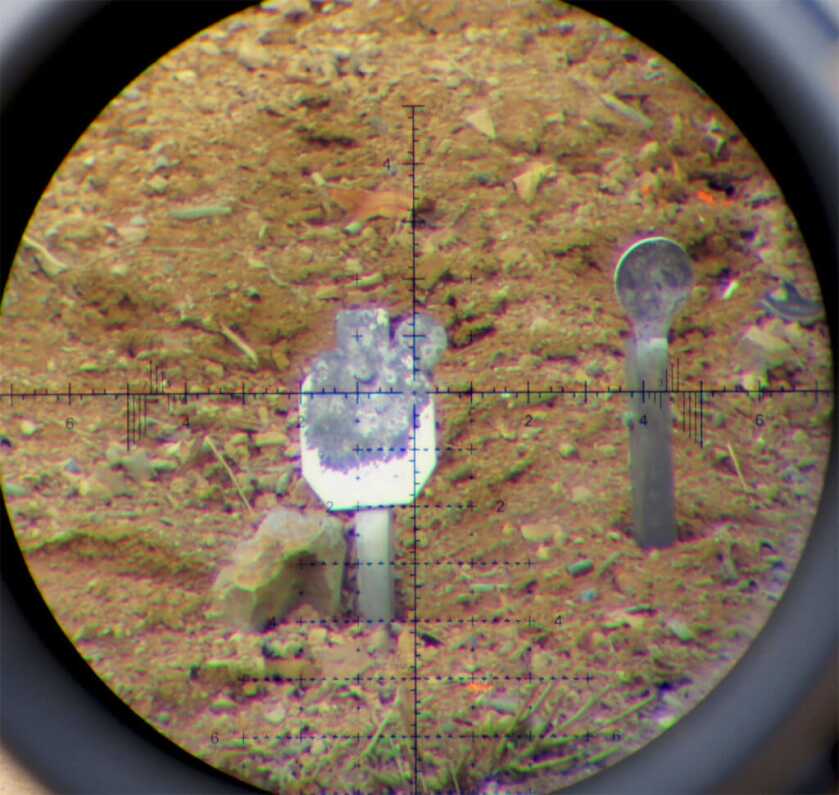
The turrets have matching milliradian adjustments and the side focus parallax knob adjusts from 25 yards to infinity. While working the turrets I noticed that the feel of the clicks was tactile and audible, maybe not as crisp as the XTRIII but still nice.

Since both elevation windage turrets are locking, they have to be pulled up or out to disengage the lock in order to make adjustments. The locking feature is a nice touch that will keep the turrets from inadvertently adjusting themselves coming out of a case or pack.

Setting the zero stop once I finished sighting in is actually more akin to one of my Nightforce scopes than the XTRII or XTRIII. It’s a simple process; just loosen three set screws around the zero stop clutch, rotate it clockwise until it hits the stop, and retighten the set screws. This setup also allows the position of the hard stop to be set below zero so that adjustments can be made in the future without having to reset everything.

Similar to the RT6, the magnification ring has dovetail cuts that correspond to the fin-type throw lever so it can be re-positioned as needed. I thought this was an especially nice touch considering that in the past I’d had issues with certain integral throw levers getting in the way of the bolt knob with no way to reposition them. Rounding out the scope is the fast adjust eyepiece that makes sure that SCR2 reticle is nice and crisp when you take those long range shots.

Mechanical Performance
Of course, the reason most of you are really here is to read how this optic actually performed. So first up, let’s talk about mechanical tracking because, in my opinion, if a scope doesn’t track properly then it’s next to useless for long range shooting. I mounted the Burris on a Bergara B14R in preparation to run the 10 mil tall target test to test the accuracy of the adjustment and make sure it tracks true. I’m going up to 10 mils because usually if a scope is going to have issues, it’s going to be apparent within the first 10 mils of dialing on elevation.
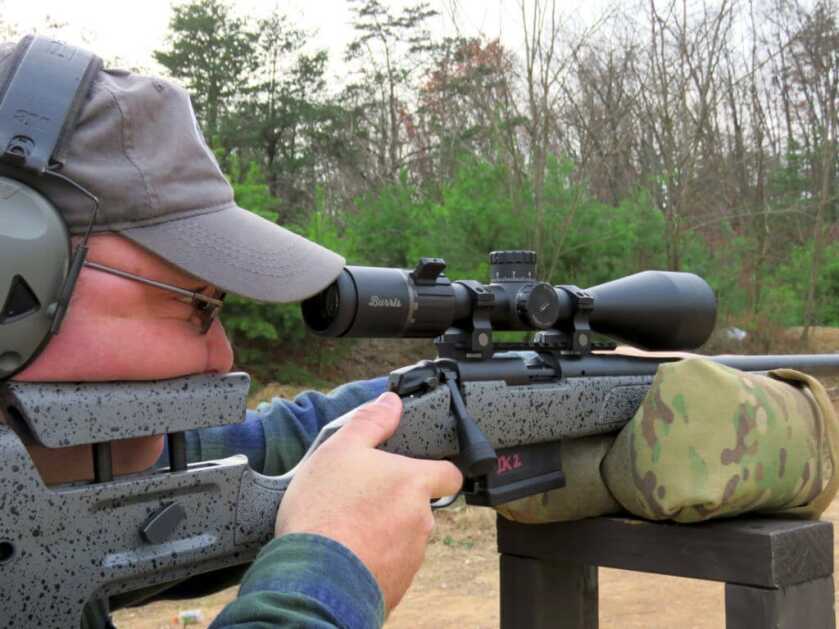
The tall target is really simple to set up, it’s just ¾” pasters laid out every 4 ½” along an 18” length, which equated to a zero point, 2.5, 5, 7.5, and 10 mils. Additional pasters were added on either side of the vertical so that I’d have points that required elevation and windage too. Shooting from the bench with a rear bag I held on the bottom paster and dialed up the requisite amount and fired one shot at each paster up to 10 mils. Then I dialed back down to zero and repeated the run again so that ideally there would be two holes in each paster. When it came to the side pasters I measured the correction using the SCR2 reticle and dialed that correction on. To my satisfaction the RT25 performed with flying colors on each relay, hitting each mark with an excellent return to zero afterward. The only issue I ran into was when a shooter next to me decided to touch off a braked .300WM just as I was breaking my shot. I came away from the bench content with the mechanical capabilities of the scope, confident that when I started to stretch the legs of the .22 out, it would be up to the task.
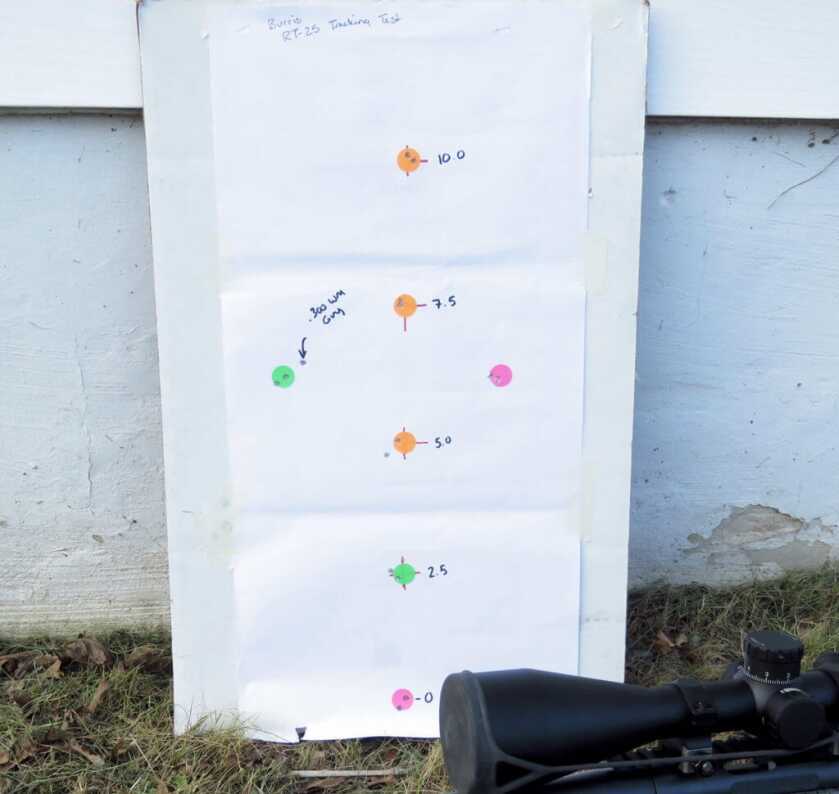
I figured one of the best ways to put the scope through its paces was to use it in conditions it’s likely to see. So, I signed up for a NRL22X match that promised challenging stages with everything from moving targets to 400-yard shots. I won’t give you a blow by blow of the match but it was a great test of the scope’s abilities. During the ELR stage, I had two targets at 350 and 400 yards but it required dialing on all 15 mils of elevation and using the SCR2 for additional hold over. The layout of the reticle made holding over the 1.7 and 5.2 mils respectively much easier, in addition to 1 mil of wind, letting me get consistent hits. A match like this one was about as thorough a way you can mechanically test a scope as I went up and down in adjustments constantly during the day. Although I finished about the middle of the pack, I can’t blame any of that on my equipment, least of all the RT25.
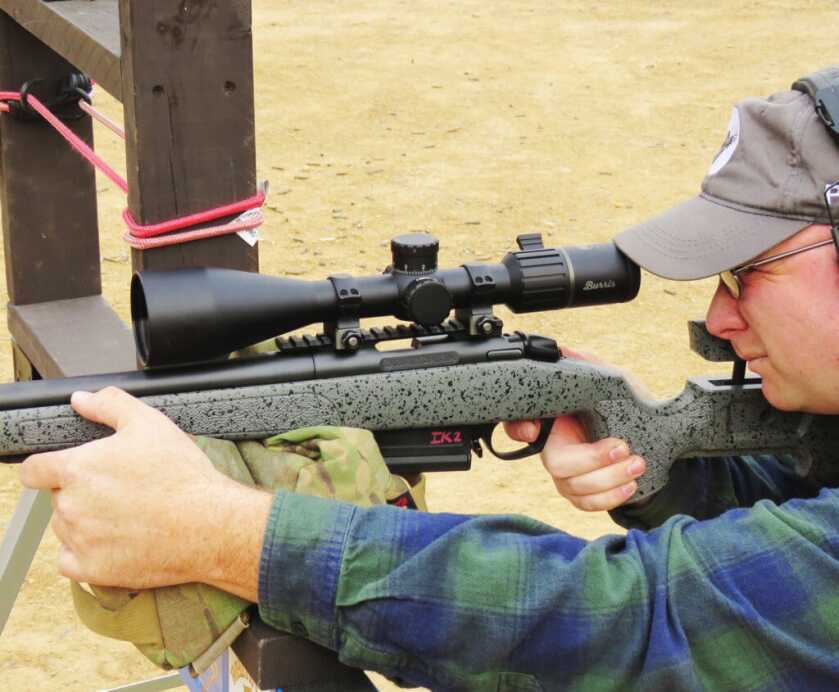
Optical Performance
When it comes to glass, sometimes scopes in the sub-$1,000 bracket can be hit or miss, especially with higher magnifications. After demonstrating its mechanical abilities, I found that the RT25 turned out to be a pretty solid performer optically as well. I wouldn’t say that it’s hitting above its weight but it will hang with its contemporaries in the same price bracket. On high power when looking at high contrast objects I did notice that chromatic aberration was present but it wasn’t overpowering.

For those that don’t know, chromatic aberration is that purple or yellowish coloration that you’ll see around the edges of high contrast objects. It’s annoying but doesn’t really stop you from seeing or being able to hit your target. The color and contrast when looking at the target was also pretty good, not quite what I’d call true to life but it wasn’t dark and dingy either, particularly on high power. The resolution when looking at distance objects was surprisingly good also, while collecting data for the NRL22X match I was able to discern .22 impacts on steel at 200 and 300 yards without much difficulty. When I was using the scope for glassing, I noticed that I could easily count the individual slats of siding on a house over 1,200 yards away. Although, seeing clearly into the shadow created by one of the corners of the house did present a bit of a challenge, then again, it was about ¾ of a mile away.
Edge to edge sharpness is very good with no discernable distortion from one side of the field of view to the other. The eye box is tight up on high magnification but that’s not exactly uncommon with scopes in this price bracket, so having a solid cheek weld is important. Due to the first focal plane placement of the reticle, it will be accurate at any magnification, however, this does carry some disadvantages in certain situations. In low light or dark backgrounds, the fine details of the reticle can be hard to pick up on lower magnifications, forcing you to stay at a higher power. For me, this limit is about 11X and below that, I have trouble making out the 0.2 mil details of the reticle to adequately use it for hold overs. At the NRL22X match, this wasn’t a major concern as most of the time I was at 12X and above for the entire match.
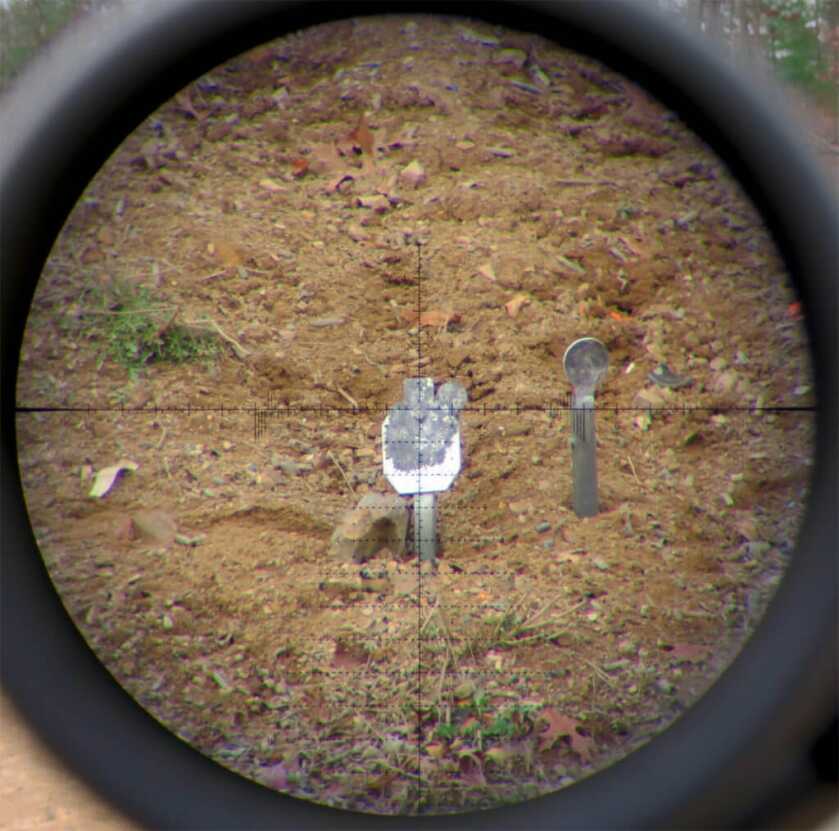
The parallax adjustment knob rotates smoothly and I appreciated that it didn’t have any range numbers etched onto it, which are rarely accurate anyway. During the NRL22X match, shooting targets from 25 to 400 yards, that knob got used a good bit to make sure the reticle and image were focused.

At close range, the scope has a shallow depth of field so if you’re going from 25 to 50 yards you might be ok but if you’re pushing out to 100, you’ll have to make an adjustment. That being said, the depth of field improves significantly as the range increases and by the time we were shooting at 350 and 400, I could find a good middle ground and be fine.
Gripes
I do have a few minor gripes with the scope but I will be fair about it. The first is the 8 mil per turn turrets, which in this day and age don’t make much sense to me since 10 mil is becoming so common. It will force me to make sure I’m dialing the right elevation when going long and a secondary line of numbers would’ve been nice to mitigate mistakes. Truthfully though, if you can do 3rd-grade math you’ll be fine and there’s always the zero stop to save the day.
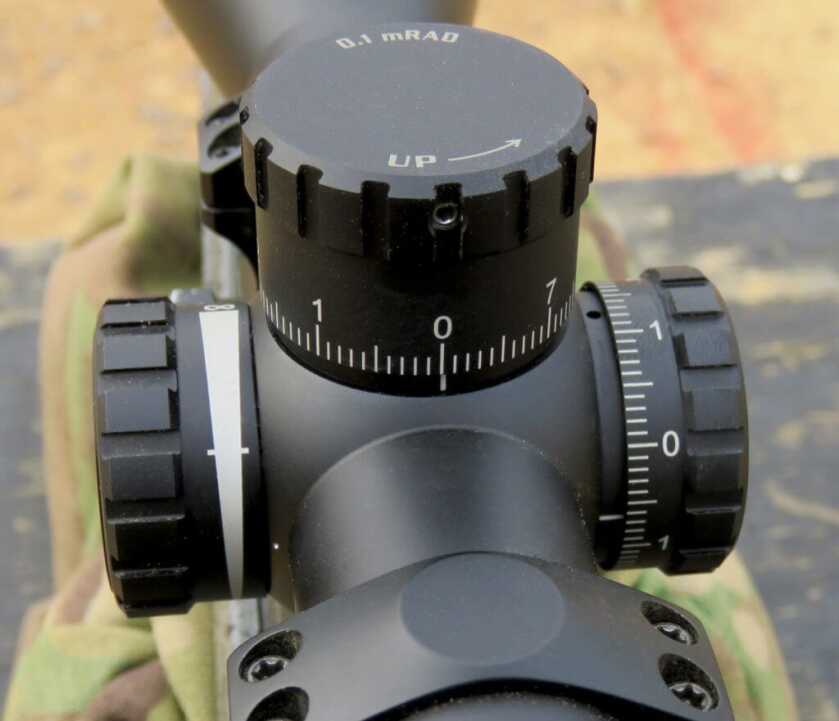
My second gripe is with the elevation turret itself, which has a small amount of side to side lash when in the unlocked position. The amount of lash isn’t any more than the width of the indicator line so there won’t be any confusion where you are in your adjustments, it’s just a nit-picky thing.

My last one is that the scope is Made in China. It’s unfortunate but I don’t think it should detract from the fact that this is a good, reliable scope, just as plenty of other scopes are that come from across the sea.
In Conclusion
For a beginner that wants to get started in long range shooting or precision rifle competition, the RT25 is a very good option. If anything should go wrong with the scope it’s covered by the Burris “Forever Warranty” that doesn’t require a warranty card, receipt, or require you to be the original owner. If you have an issue, give them a call, and they’ll get you sorted out. I’ve used a lot of different scopes in my time but these Burris scopes have been consistently good time and again. I highly recommend you check out the RT Long Range line if you need an optic that will perform without breaking the bank. MSRP on the RT25 is $734 and is available at most dealers and distributors.
For more information check out Burris Optics.

Awesome article, but F China.
I’ll pay more for a similar quality product from a country that wont use the money to pursue world domination via communist virulence.